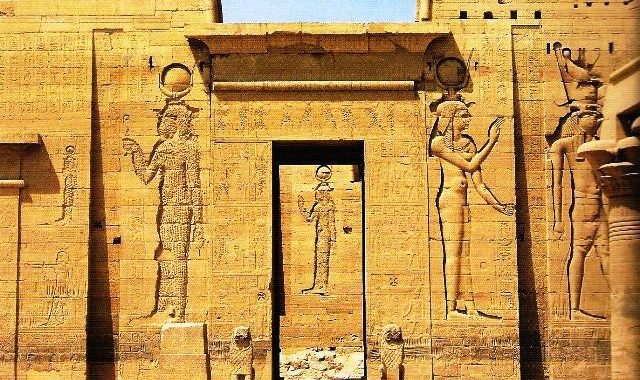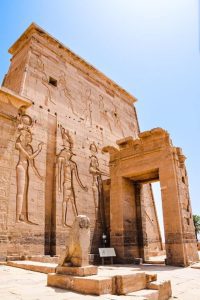
Unveiling Philae Temple Facts
Unveiling Philae Temple Facts: A Journey Through Ancient Egypt
Nestled on Agilkia Island in the Nile River, the Philae Temple is a captivating site that offers a window into the religious and cultural life of ancient Egypt. This temple complex, primarily dedicated to the goddess Isis, is rich with history and architectural beauty.
Philae Temple Facts: Dedicated to the Goddess Isis
One of the most fascinating Philae Temple facts is its dedication to Isis, the goddess of magic, motherhood, and fertility. Isis was one of the most revered deities in ancient Egypt, and her worship extended far beyond the country’s borders.
The temple served as a major pilgrimage site where devotees sought her blessings and guidance.
Philae Temple Facts: A Blend of Cultures and Eras
Construction of the Philae Temple began during the Ptolemaic dynasty, around the 3rd century BCE, and continued into the Roman period. This long construction period resulted in a fascinating blend of architectural styles. Among the
Philae Temple facts is the temple’s reliefs and inscriptions, which reflect a mix of Egyptian and Greco-Roman influences, showcasing the cultural exchanges that occurred over centuries.
The Original Island Location
Originally, the temple was located on Philae Island. However, the construction of the Aswan Low Dam in the early 20th century led to the island being submerged for much of the year. This posed a significant threat to the temple’s preservation, as the rising
waters damaged the structures and eroded the island.
Philae Temple Facts: A Monumental Relocation
One of the most remarkable Philae Temple facts is its relocation. In the 1960s, the construction of the Aswan High Dam threatened to permanently submerge the temple. In response, an international effort led by UNESCO was launched to save this invaluable piece of history.
Between 1972 and 1980, the temple complex was meticulously dismantled and relocated to the nearby Agilkia Island. This massive undertaking involved moving over 40,000 stone blocks, each carefully numbered and reassembled, preserving the temple for future generations.
Philae Temple Facts: Architectural Marvels
The Philae Temple complex is a stunning example of ancient Egyptian architecture. Among the Philae Temple facts is the grand entrance known as the First Pylon, adorned with intricate carvings depicting scenes of the pharaohs making offerings to the gods.
Beyond the pylon lies the Hypostyle Hall, a vast space supported by towering columns decorated with lotus and papyrus motifs. The inner sanctum, or sanctuary, was the most sacred part of the temple, where the statue of Isis would have been housed.
Philae Temple Facts: The Sound and Light Show
One of the most popular attractions at the Philae Temple today is the Sound and Light Show. This evening spectacle brings the temple’s history to life through a combination of dramatic lighting, music, and narration. As you wander through the illuminated ruins,
you’ll hear stories of the gods and pharaohs who once walked these grounds, creating an unforgettable experience that transports you back in time.
A Center of Pilgrimage
In ancient times, the Philae Temple was a major center of pilgrimage. Devotees from across Egypt and beyond would travel to the island to pay homage to Isis and seek her blessings. The temple’s strategic location at the crossroads of trade routes also made it
an important cultural and economic hub, attracting merchants and travelers from diverse backgrounds.
Philae Temple Facts: The Last Bastion of Ancient Egyptian Religion
Cultural Significance and Preservation
Today, the Philae Temple is a UNESCO World Heritage Site, recognized for its cultural and historical significance. The temple’s preservation is a testament to international cooperation and the importance of safeguarding our shared heritage. Visitors to the site can explore the
beautifully restored structures, gaining insight into the religious and artistic achievements of ancient Egypt.
Visiting Philae Temple: Tips and Insights
For those planning a visit, the Philae Temple is accessible by boat from Aswan. The short journey across the Nile offers stunning views of the surrounding landscape, setting the stage for your exploration of the temple complex. Once on Agilkia Island, you can wander through the
temple at your own pace or join a guided tour to learn more about its history and significance.
Tips for Visiting
- Best Time to Visit: The cooler months from October to April are ideal for visiting, as the temperatures are more comfortable for exploring the site.
- Guided Tours: Consider hiring a knowledgeable guide to enhance your understanding of the temple’s history and architecture.
- Photography: The temple’s intricate carvings and stunning views make it a photographer’s paradise. Be sure to capture the beauty of the site, especially during the golden hours of sunrise or sunset.
The Human Connection
What makes the Philae Temple truly special is the human connection it fosters. As you walk through its ancient halls, you can almost feel the presence of the countless individuals who have visited this sacred site over the millennia. From the priests who performed rituals to the pilgrims
who sought divine intervention, the temple is a living testament to the enduring human quest for meaning and connection.
In conclusion, these Philae Temple facts highlight the enduring legacy of ancient Egyptian civilization. Its rich history, stunning architecture, and successful preservation make it a must-visit destination for anyone interested in exploring the wonders of Egypt. Whether you’re drawn
by the stories of the gods, the allure of ancient architecture, or the beauty of the Nile, the Philae Temple offers an unforgettable journey into the past.
Luxor Aswan: Exploring Egypt’s Timeless Wonders – (marouskatravel.com)
